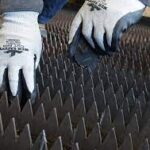With wild fires burning out of control in California, it is a reminder that we all have to be vigilant about fire safety. From a workplace perspective, fire safety has come a long way since the tragedy at the Triangle Shirtwaist Factory in New York City, that killed 146 garment workers -123 women and 23 men, in 1911. Today, there are standards put in place by the Occupational Safety and Health Administration (OSHA) to guard against hazards like locked fire exits and inadequate fire extinguishing systems.
However, according to OSHA, workplace fires and explosions kill 200 and injure more than 5,000 workers each year and costs businesses more than $2.3 billion in property damage. Explosions and fires account for 3% of workplace injuries and have the highest casualty rate of all probable workplace accidents.
Unexpected explosions and fires in the workplace are frequently caused by risk factors such as faulty gas lines, poor pipefitting, improperly stored combustible materials or open flames. These incidents cause damage to the respiratory system, varying degrees of burns and potential disfigurement.

There are four types of injuries commonly associated with fires and explosions:
§ Primary Blast Injuries: Occurs due to the effects of pressure on body tissues, affecting ears, lungs and the GI tract
§ Secondary Blast Injuries: Occurs when flying objects strike nearby workers
§ Tertiary Blast Injuries: High-energy explosions can lift someone off the ground and cause them to fly into surrounding objects
§ Quaternary Blast Injuries: Crush injuries, burns, inhalation of toxic substances and everything else that occurs because of an explosion
Explosions and fires in the workplace can be extremely dangerous and you should take the necessary steps to ensure maximum fire safety.
We have outlined 12 ways you can keep your workplace safe below:
1) Accessibility
Provide full accessibility to electrical control panels. Never block the panels, which are used to shut down power in an emergency, with materials or other equipment. Also, never block sprinklers, firefighting equipment or emergency exits and observe clearances when stacking materials.
2) Good Housekeeping
Clutter not only provides fuel for fires but also prevents access to exits and emergency equipment. Keep your workplace as clutter-free as possible and ensure equipment and other materials are properly stored.
3) Proper Waste Disposal
Discard fire hazards like oily rags by placing them in a covered metal container and emptying it on a regular basis.
4) Maintenance
Make sure the machines in your workplace are properly maintained to prevent overheating and friction sparks. Check and perform maintenance on machines regularly and keep a record of this routine maintenance.
5) Report Electrical Hazards
Unless you are qualified and authorized, you should never attempt electrical repairs. Faulty wiring and malfunctioning electrical equipment are key contributors to workplace fires. If you notice something does not look right, immediately notify the proper person in your facility.
6) Safe Chemical Use & Storage
Always read the label and the Material Safety Data Sheet to assess flammability and other fire hazards of a substance. When using and storing chemical materials, always do so in an area with adequate ventilation. Make sure your employees have the proper protective equipment for handling hazardous materials.
7) Precautions In Explosive Atmospheres
Follow all recommended and required precautions to prevent ignition in potentially explosive atmospheres, such as those containing flammable liquid vapors or fine particles. These precautions include non-sparking tools and proper static electricity control.
8) Maximum Building Security
To help prevent arson fires, always lock up as instructed, report suspicious persons or behavior and never leave combustible garbage outside or near your building.
9) Smoke Areas
Ensure that there is a smoke area available and that all workers who smoke on the job are using it. Proper extinguishing of smoking materials should always be enforced and signs reminding employees to properly discard their cigarettes should be provided as well.
10) Fully Charged Fire Extinguishers
Check fire extinguishers often by looking at the gauges and making sure they’re fully charged and ready for use. If they’re not fully charged or if the attached tag indicates that the last inspection occurred more than a month ago, call for maintenance. Also, encourage all workers to learn how to use a fire extinguisher and provide the proper training.
11) Emergency Numbers and Proper Signage
Emergency phone numbers, as well as your company address, should be posted by the phone station for quick access. If necessary, create additional information sheets in the native languages for your employees. Make sure you have exit signs installed in your facility and a fire evacuation plan in the event of an emergency.
12) Fire Drills and Evacuation Plan
Conduct fire drills at least twice a year and have a designated spot where employees will meet once they exit the building. Assign employees to be fire drill captains and make sure everyone knows what the proper procedure is. Review your plan with your local fire company to assess its effectiveness.


